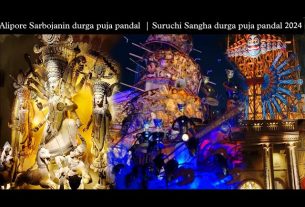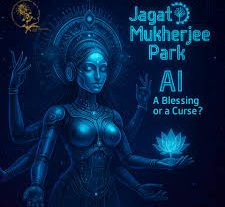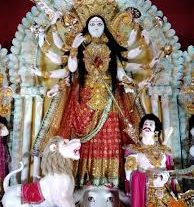North Kolkata’s iconic Ahiritola Sarbojanin Durga Puja 2024 took devotees on an artistic pilgrimage through memory, culture, and history under the poignant theme “Khēyāl Setu Vaitaraṇī“. This visionary theme, conceptualized by artist Anirbān Das, celebrated not just the festival of Durga Puja, but the living legacy of the Ahiritola Ghat, weaving together stories of spiritual luminaries, colonial-era theatre lanes, and the soul of old Kolkata—all anchored around the ghats where creation and immersion of Durga idols begin and end.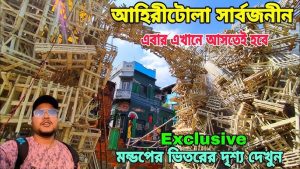
Over some 106 years of celebration, Ahiritola Sarbojanin has remained steadfast in honoring tradition, yet 2024 proved that bold storytelling and heritage can converge in a single immersive pandal. Let us step inside this remarkable narrative, exploring the design, symbolism, rituals, communal energy, cultural programming, and lasting impact on the city’s collective consciousness.
Theme & Concept: Khēyāl Setu Vaitaraṇī — Bridges of Nostalgia
At its heart, Khēyāl Setu Vaitaraṇī explores the bridges between memory and reality, childhood and community, creation and immersion. The theme pays homage to Ahiritola Ghat—the sacred waterway that transports clay idols from Kumartuli to their final rites on Vijayadashami. This Ghat has seen Ramakrishna Paramhansa, Rani Rashmoni, and generations of karamcharis and pilgrims; thus its history intertwines with the spiritual and the mundane.
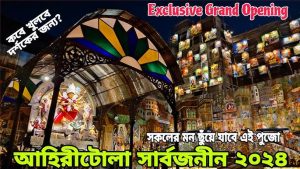 Artist Anirbān Das describes the theme as a symbolic ferry across collective memory—a visual bridge (Setu) connecting the past and present, carrying the departed idol (Vaitaraṇī) from creation to dissolution. Every structural element, every path through the puja, reflects this passage—ritualized, communal, spiritual.
Artist Anirbān Das describes the theme as a symbolic ferry across collective memory—a visual bridge (Setu) connecting the past and present, carrying the departed idol (Vaitaraṇī) from creation to dissolution. Every structural element, every path through the puja, reflects this passage—ritualized, communal, spiritual.
Pandal Design: Where History Meets Artistry
The pandal architecture transported visitors through layered experiences:
-
Ghat façade at the entrance: Step onto a wooden jetty replica, flanked by jute lanterns and mock boats, instantly evoking the feel of the riverbank.
-
Narrow lane installations: Simulating vintage North Kolkata alleys—with artisan workshops, local grocery shops, and old theatre posters—evoking Yatriparā and Company Bagan theatre heritage.
-
Bridge-like canopy: Overhead cloth canals crisscrossed, symbolizing the Setu over which memory flows; fabric mimicked gentle currents shimmering with dingy yellow and off-white light.
-
Immersion-themed inner sanctum: Walls adorned with sepia-toned murals of immersion processions in the 1950s, leading toward the idol’s sanctuary.
Color palette stayed earthy—ochre, terracotta, faded blues, and deep greens—contrasting with bursts of diyā light, reminding visitors of old lamp-lit evenings along the Hooghly.
Durga Idol: A Guardian of Memory
At the heart stood the majestic Durga idol, a serene embodiment of tradition and narrative:
-
Crafted in classic Bengali style by Kumartuli artisans.
-
Adorned with motifs of boats, lotus, and traditional clay while sustaining solemn poise.
-
Her eyes conveyed both motherly compassion and collective memory, as if watching over the entire lifecycle of the puja and the eroding memories of the lost ghat-side theatres.
The idol was surrounded by offerings from local residents—handwoven fabrics, old photographs, jute artifacts—symbolizing each household’s contribution to the communal memory.
Rituals: Continuity Amid Nostalgia
Ahiritola Sarbojanin is renowned for preserving authentic rituals:
-
Bodhon on Shashthi, invoking Durga’s presence amid calm rituals at dawn, set by temple bells and slowly rising incense.
-
Pushpanjali during Saptami–Navami, with rhythmic dhak beats, children singing choir-style recitals,
 and devotees gently tossing frangipani petals.
and devotees gently tossing frangipani petals. -
Sandhi Puja—performed under the symbolic canopy bridge—when the lighting and mist machines simulated twilight, adding dramatic momentum to the ritual’s crescendo.
-
Hukum-Chamara ceremony, traditionally at this locality, honored more than deity; it honored the artisans and Ganga-bound clay.
Community, Crafts & Cultural Expression
Ahiritola is a locale where communities intermingle:
-
Artisan stalls: Displayed old photographs from Yatriparā, posters of Jatra performances by theatre legends, and folk paintings.
-
Gramophone corner: A vintage gramophone played old Bengali songs and theatre dialogues, echoing the Akashvani-era nostalgia.
-
Interactive exhibits: Visitors could record a memory in a “Memory Lane” booth about their own Puja or childhood on the ghat, creating an ever-growing archive.
Cultural Programs: Performances Across Time
Evening programs honored both legacy and innovation:
-
Folk music renditions: Baul and Bhatiali songs evoking rivers of memory.
-
Theatre skits: Reenactments from Yatriparā dramas—on family bonds, ghat rituals, colonial-era social conflict.
-
Children’s narrative troupe: Stories of Ramakrishna and local legends, interwoven with immersion rituals.
-
Elderly storytelling circles: Recounted personal memories of Rani Rashmoni, early Durga processing at Ahiritola, and the lost boatyards.
Visual Splendor: A Photographer’s Paradigm
The décor and ambiance provided photogenic moments:
-
Mint-green boats lined up along fabric pathways.
-
Diyā-lit immersion arches glowing against terracotta frames.
-
Old theatre posters layered on walls beneath the idol.
-
Smoky atmosphere during dhunuchi naach, illuminated by spotlights.
♻️ Sustainability & Social Engagement
This year, sustainability remained core:
-
Bamboo and burlap construction, replaced plastic sheeting.
-
Roof water harvesting panels, funneling rain into lakes.
-
Reusable lamps and cloth diyā, reducing waste.
-
Puja-run NGO stalls supported local fishermen families displaced by floods.
-
Food stall run by physically challenged youth, participating in revenue-sharing.
These initiatives rooted the festival in civic responsibility and ecological consciousness.
Impact & Legacy
Bagging awards and recognition for immersive narrative design, Ahiritola Sarbojanin became a benchmark in:
-
Literature-infused pandal art: Merging Tagore-style storytelling with community identity.
-
Oral history preservation: Through interactive memory recordings.
-
Thematic simplicity married with emotional depth: No over-the-top props; instead, carefully placed objects and stories.
Visitor Experience: Walking Through Time
-
Enter through boat deck styled gates.
-
Walk under canopy of flowing cloth “waterways.”
-
Pause at artisan stalls, take selfies near gramophone.
-
Join children storytelling circle.
-
Stand before the idol in hushed awe.
-
Stay after dark for the interactive street theatre and dhunuchi fragrance.
Final Reflections: Why Khēyāl Setu Vaitaraṇī Matters
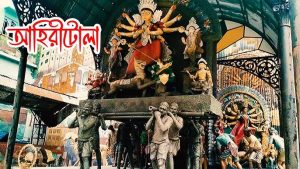 Ahiritola Sarbojanin Durga Puja 2024 was more than a festival—it was a living museum of memory, a pilgrimage through yesteryear Kolkata, and a reminder that community festivals can transcend decoration to speak deeply of identity, ecology, history, and art.
Ahiritola Sarbojanin Durga Puja 2024 was more than a festival—it was a living museum of memory, a pilgrimage through yesteryear Kolkata, and a reminder that community festivals can transcend decoration to speak deeply of identity, ecology, history, and art.
As the final immersion took place, and the river carried away the clay figure, the message remained: Durga Puja is not just episodic celebration—it is a bridge connecting who we were, who we are, and who we aspire to become. And in the heart of Ahiritola, with its ghat-side memories and communal spirit, that bridge was lovingly rebuilt year after year.


